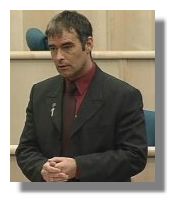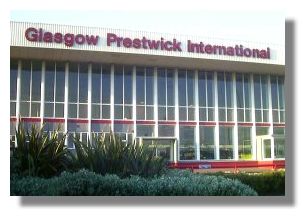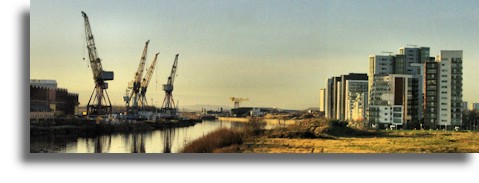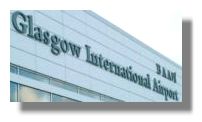Scottish News Items From Ten Years Ago - and Now
- July 2002 - July 2012
Background
The Scottish Snippets (which began in 1997) was published regularly and covered a wide range of items of news and Scottish culture. After over 590 issues of these Scottish Snippet, the newsletter had to be brought to an end - though it is still kept alive with a newsletter on additions to the Rampant Scotland site which are sent to subscribers every couple of weeks. I often refer to the back issues of the Scottish Snippets to check on news items that were covered and it is surprising to see how many of the issues are still relevant today! So here are selected items from ten years ago for the month of July 2002 - with an additional comment from today's perspective. It is surprising how some things never change - and also how things have developed ten years later!

House Prices Go Through the Roof(2002)
According to figures published by the Nationwide Building Society, the annual rate of house price increases rose from 8.5% in the first quarter of 2002 to 12.5% for the three months to the end of June. The increases have been accompanied by a boom in applications for new loans reaching record levels. The British Bankers Association (BBA) said that its members had approved 253,900 new mortgages in the UK in May, worth £16.5 billion. This was the highest since their records began in 1997 (when there was an increase in the number of BBA members). In Scotland, there are dramatic variations in the annual increases in house prices, ranging from 1.29% in East Ayrshire, through 8.67% in Glasgow, to 16% in Edinburgh and 25.96% in Moray. Despite the overheating in the property market, the Bank of England's Monetary Policy Committee left interest rates unchanged at 4% at their meeting this week.
Loans for House Purchases and House Prices Decline (2012)
The financial crisis which has affected most developed countries also had an impact on Scottish mortgages and house prices. Number of loans for house purchases and the prices of houses declined from 2007 to 2010, though there was a slight recovery in the number of loans, year-on-year in 2010. In 2010, there were 47,200 loans worth £5.3 billion taken out for house purchase in Scotland, a less than 1% increase in number from 2009, the year that saw the lowest number of loans in 30 years. After dropping in 2009, average house prices in Scotland increased, ending 2010 at £167,815. Annual house price inflation in Scotland for 2010 was 2.8%, less than half of the 7.4% seen UK.-wide. Base interest rates in the UK moved to 0.5% in March 2009 and have remained there ever since.Gains Predicted for Scottish Socialist Party(2002)
The latest NFO System Three opinion poll for the Herald newspaper is predicting that the Scottish Socialist Party, led by Tommy Sheridan (pictured here), its present sole Member of the Scottish Parliament, will win up to seven seats on the elections next May. The party has grown to 8% in the regional lists, that part of the election process which involves proportional representation. It could mean that Robin Harper, the sole member of the Green Party in the Scottish Parliament could lose out - though the Greens may pick up seats in rural areas. The Conservative Party are predicted to win only 12 seats, down from 19. Currently, Labour are predicted to lose two seats and the Scottish Nationalist Party could gain two, with the Liberal Democrats unchanged. But ten months is a long time in politics.
Photograph courtesy of the Scottish Parliament © Web site.
Scottish Socialist Party Turmoil (2012)
In the 2003 elections to the Scottish Parliament saw the SSP gain five additional seats across Scotland. But in November 2004 the charismatic Tommy Sheridan announced his resignation as convener of the party, citing personal reasons. He was later involved in a high profile libel case involving the News of the World. In August 2006, Tommy Sheridan announced his intention to leave the Scottish Socialist Party and found a new socialist political party called Solidarity. In the 2007 election, the Scottish Socialist Party lost all remaining seats and when the SSP contested all eight regions in the Scottish Parliament election in 2011 no candidates were elected, all losing their deposits.
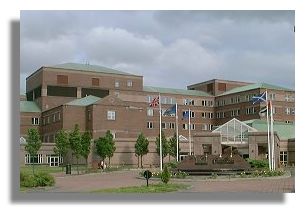
HCI Hospital Takes First Patients (2002)
The private HCI hospital in Clydebank, which the government has bought for a bargain price of £37.5 million, took its first National Health Service patients under the new regime this week. The deal was signed at the end of last week and the 540-bed hospital and all its staff and equipment are now available to the NHS. The hospital specialises in complex heart operations, major orthopaedic procedures such as knee replacements, plastic surgery and heart investigations.
Golden Jubilee National Hospital (2012)
When it was taken over by the National Health Service, the former HCI Hospital was initially known as the National Waiting Times Centre. But it was soon renamed the Golden Jubilee National Hospital. Its Orthopaedics department has pioneered a technique for post op pain relief, quick mobilisation and early discharge of patients. It is one of the biggest centres in the world in use of computer assisted orthopaedic surgery and has done extensive research in this field. A new two-theatre Orthopaedic suite was added in 2003, amongst the most advanced in Europe. The hospital also houses the headquarters and western call-centre for NHS24, the telephone helpline.
(2002)
Britain's Fastest Growing Airport
While growth may be from a relatively small base, there is no denying that Prestwick Airport in Ayrshire (which trades as Glasgow Prestwick International, even though it is 30 miles from the city) is growing at a faster rate than any airport in Britain. Traffic is 35% ahead of last year's figures, with 1.3 million passengers using the airport. The airport's biggest user is Irish airline Ryanair, which swelled its own passenger numbers by 51% last month compared with the same month a year ago. Back in 1992, passenger numbers were small, with the facility being used mainly by cargo after trans-Atlantic traffic had been moved to Glasgow Airport.
Passenger Numbers Nose-dive at Glasgow Prestwick International(2012)
Prior to 1992, the airport had struggled for survival but was rescued by a Canadian entrepreneur Matthew Hudson. He built the airport's own railway station on the existing Ayrshire Coast Line (Glasgow–Ayr), which runs straight past the airfield, making the airport the "first in Scotland to have its own railway station". Irish budget airline Ryanair opened routes to the airport from Dublin and London. Passenger numbers grew from 1,496,000 in 2002 to 2,415,000 in 2008. Matthew Hudson sold Prestwick Airport to Stagecoach, a large Scottish transportation group but it was then sold to Infratil, a New Zealand investment company which also owns Wellington International Airport. Infratil completed a major £3 million refurbishment of the terminal building, and also - controversially - rebranded the airport using the controversial phrase "Pure Dead Brilliant", taken straight from the Glasgow patter. But following the financial downturn in 2007/8, passenger numbers declined, reaching just 1,297,000 in 2011, lower than the number in 2002.
Slow Growth of Scottish Economy (2002)
The positive comments of the Governor of the Bank of England were in sharp contrast to a gloomy forecast by the respected Fraser of Allander Institute, part of Strathclyde University, which estimates that growth in the Scottish economy will amount to only 0.9% in 2002, little more than half of the 1.7% predicted for the UK economy as a whole. Scottish manufacturing has been stuck in recession for six consecutive quarters and it is only due to the ever-resilient service sector that the total economy is showing any signs of growth. However, even here, the forecast is for growth of 2.1% in the service sector in 2002.
Slow Growth of Scottish Economy (2012)
That "ever-resilient" service sector, particularly banking and financial services went into a nose-dive in 2007/08. Scotland has long been recognised internationally as the most important UK financial centre outside London and the South East so the financial crash had a greater impact on Scotland than elsewhere. The Royal Bank of Scotland only survived as a result of a government (that is tax-payer) bail-out which meant that the British Government now owns more than 57% of the bank's equity share capital. Bank of Scotland (part of the HBOS group following the merger with Halifax Bank) was in an even worse position due to exposure to subprime and other bad lending. Encouraged by the UK government, Bank of Scotland was taken over by the Lloyds TSB in September 2008. The price was set at the equivalent of 232p per share, which was less than the 275p price at which HBOS had raised funds earlier in 2008. Lloyds TSB discovered later in 2009 that the exposure of Bank of Scotland on bad loans would produce a loss of £10bn at HBOS because of a deterioration in the housing market and weakening company profits. Lloyds Banking group also required to be propped up by government funding. As a result of providing the finance to keep Royal Bank of Scotland and HBOS and latterly Lloyds Banking Group in business, the UK Treasury has "invested" £37bn ($64bn, €47bn, equivalent to £617 per citizen of the UK) of new capital into Royal Bank of Scotland Group plc, Lloyds TSB and HBOS plc. The government stresses, however, that it was not "standard public ownership" (or "nationalisation") and that the banks would return to private investors "at the right time."
In July 2012. statistics showed that the UK economy contracted by 0.7% between April and June and so remains in economic recession where it has been for the last two quarters. That means the UK economy is now 4.5% below the previous level of output reached in 2008. This situation has been described as "the worst double dip recession in 50 years." The GDP figures showed a very sharp drop in the construction sector, possibly as a result of reduced public spending on capital projects, a lack of confidence in the housing sector and reluctance by individuals to undertake home improvements.
The latest quarterly figures on the Scottish economy are not yet available but in March it was 3.9% lower. In March the chief economist at the Scottish government estimated growth in the Scottish economy would remain "fragile" this year, increasing through 2013 to return to pre-recession levels "some time in 2014".
Plans for Clyde Commercial Development Revealed(2002)
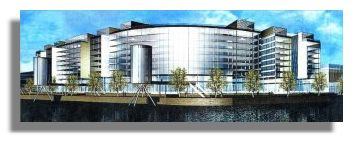
The picture is an artist's impression has been published of the commercial development on a mile long stretch of the north bank of the Clyde in Glasgow, from the Scottish Exhibition and Conference Centre all the way downriver to the Clyde Tunnel. The drawings show a massive glass-fronted building which will give the occupants a fine view of the river - now much improved from the days when Glasgow was a major industrial city. The £500 million harbour development will also include 2,500 new homes, 650 of which will be built once the demolition of the Meadowside Granary is completed later this year. In order to allow a clear view of the harbour development from the west end of Glasgow, the Clydeside Expressway is to be lowered by several yards and a redundant railway embankment will be removed. The shopping and leisure development will be linked to a revamped Partick Interchange and underground station.
Glasgow Harbour (2012)
Phase 1 of the redevelopment of the north bank of the Clyde, the Glasgow Harbour Project, was on the site of the former Meadowside Granary, Yorkhill Quay and confluence of the River Kelvin in Partick. It consists of high rise residential accommodation and a riverside walkway. Phase 2 of the project will include more high-rise apartment towers, including a 23-storey, 134 metres (440 ft) residential block. The area now includes the new Museum of Transport and there are plans for large-scale commercial developments at the site.In 2006, the Clyde Arc road bridge opened to traffic and a light rail metro system is planned, to be called Clyde Fastlink, to link the area to the city centre areas.
Wettest June Since Records Began(2002)
It rained every day in Glasgow in June, except on the 28th. Edinburgh was only slightly better with two dry days. Arid Aberdeen had all of three days without precipitation. The total amount of rainfall this June in terms of inches didn't break any records (there was "only" twice the normal amount in Glasgow) but the lack of dry days made it the wettest June since such records began in 1914. The rain and clouds also affected the amount of sunshine - Glasgow and Edinburgh had only around half of the normal hours of sun. Aberdeen, however, managed to reach the long-term average for sunshine hours. One consolation from the meteorologists was that the longest period of continuous rain in Britain (58.5 hours) was way back in 1903.
Wettest June Since Records Began (2012)
With low pressure over or close to the UK for the whole month, the weather was generally cool and unsettled with showers or longer periods of rain making it exceptionally wet in the south and east. The mean temperature was 0.6 °C below the 1971-2000 average, making it the coolest June since 1998. It was much wetter than normal across much of southern and eastern Scotland, especially in the Borders, Lothians and Fife where 250% to 300% of the normal amount fell. Across southern and eastern Scotland, it was the wettest June on record and the number of days with rain was among the highest in the last 50 years. It was a relatively dull month in many areas, especially in the south and east, where it was among the dullest on record. However, sunshine totals were somewhat above normal in Shetland, the Western Isles and along the north-west coast.
Smoking MSPs Won't Have to Step Outside (2002)
You see them skulking outside many large buildings - including the temporary home of the Scottish Parliament (though many there use an internal quadrangle, away from public gaze). Nicotine addicts, who are banished from their desks when they want a quick cigarette, find doorways and corners where they can shelter out of the wind and rain. But that won't happen with the £280 million (or is it going to be more?) new Scottish Parliament building going up in Holyrood, Edinburgh. A dedicated smoking room is to be provided for politicians, staff and press. A windowless room in the upper basement will provide space for 15 smokers at a time - and extractor fans to ensure that other rooms are not affected by the stench. Smoking MSPs welcomed the decision, but the convener of the parliament's cross-party group on tobacco control said "this simply sends out the wrong message." It is estimated that there are 13,000 deaths in Scotland each year caused by smoking-related illnesses.
Smoking Ban Improves Health(2012)
Scotland was the first country in the UK to introduce a smoke-free law in March 2006. The ban was popular with British adults when it was implemented - and a recent poll of more than 12,000 people found that 78% of adults still support it. Results show benefits for health, changes in attitudes and behaviour and no clear adverse impact on the hospitality industry. A study of bar workers, using saliva, lung function and air quality tests, showed their respiratory health had greatly improved after the laws came in, thanks to the reduction in exposure to secondhand smoke. Opponents of the legislation feared that it would push adults to smoke more at home, and therefore put children at greater risk of secondhand smoke. But Scottish evidence suggests the reverse. A Glasgow University study showed a 15% reduction in the number of children with asthma being admitted to hospital in the three years after the ban came into force in Scotland. Research from Scotland also reported a 17% decrease in heart attack hospital admissions in the year after its ban. Another Glasgow study which looked at smoking and birth rates before and after the ban found a 10% drop in the premature birth rate, which researchers linked to the smokefree laws. In 1962, about 70% of men and 40% of women in the UK smoked everywhere - on trains and buses, at work, even in schools and hospitals. In 50 years the busy street outside the pub or office is now the smokers' domain and only about 21% of men and women smoke.
Drambuie Posts Losses (2002)
The Edinburgh-based liqueur company Drambuie has announced that it recorded a pre-tax loss of £3.3 million in the 12 months to June 30, 2001, due largely to restructuring costs. Turnover, however rose from £28.6 million to £30.1 million. Drambuie was first produced commercially in 1910 using a recipe said to have been given to the MacKinnon clan in 1746 by Bonnie Prince Charlie.
Drambuie Profits Rise (2012)
Drambuie posted a 2% rise in underlying operating profits to £2.81 million in the year to June 2011 in spite of a 56% plunge in shipments to crisis-hit Greece - its third-largest market where total consumption of spirits declined by about 30% in 2010. There was good news also in a 4% rise in sales to the key US market in which it has been working to turn around a long-term decline. Shipments to the US remained the company’s biggest single market. Overall, turnover rose to £21.9m in the year to June from £19.2m in the prior 12 months. Drambuie forecast further growth in sales this financial year. Drambuie, remains in the ownership of the MacKinnon family.
Battle of the Skies (2002)
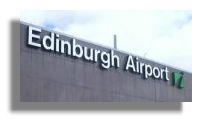
A report by the UK transport minister has sparked a debate on the future of aviation in the UK, including Scotland. Air passenger numbers in the UK are expected to more than double from 180 million a year to 400 million by 2020. More than 50 million people are expected to fly from Scotland's airports over the next 30 years. Scots, who average 1.7 trips a year, are second only to those living in the south-east of England for the number of flights per head of the population. Edinburgh airport has seen a phenomenal rise in passenger numbers in recent years and it seems that the case for a second runway there is well established. But Glasgow City Council is keen to see expansion of the airport there, which is currently the busiest in Scotland. The government report calls for the creation of an international hub airport in Scotland, with a second runway being required at either Edinburgh or Glasgow - with Edinburgh estimated to have a better financial case.
(2012)
By 1996, Glasgow International was handling over 5.5 million passengers per annum, making it the fourth largest airport in the UK. But in 2007, Glasgow International passenger numbers were surpassed by those at Edinburgh Airport. By 2011, Edinburgh airport had 9.4 million terminal passengers and Glasgow airport had 6.9 million (although that was a 5.1% increase on the previous year).
Design of New Bridge Unveiled (2002)
The winning design for a striking new bridge across the river Clyde between Finnieston and Govan were revealed this week for the first time (see artist's impression). The tied arch construction gives it a slight resemblance to the Sydney Harbour bridge, though on a much smaller scale. The four-lane bridge (with two lanes dedicated to buses and taxis) will provide access to Pacific Quay, the location of the BBC's new Scottish headquarters. Depending on how long it takes to obtain detailed planning permission, the bridge could be in operation by 2004. The bridge will also provide a direct link for vehicles and pedestrians between the Scottish Exhibition and Conference Centre on the north bank and the Glasgow Science Centre on the opposite side of the river. However, Clydefast who had planned to introduce a high-speed link between Glasgow and the Clyde coast resorts of Greenock, Dunoon and Rothesay, say that they will fight the plans for the bridge as it does not allow clearance for their 200-plus capacity catamarans.
Clyde Arc (2012)
The "Clyde Arc" bridge runs diagonally across the river Clyde at Finnieston on the north bank to Pacific Quay on the south bank. It did not open on the target date of 2004 but opened instead in September 2006. It was the first vehicle crossing to be built over the river Clyde since the Kingston Bridge more than 30 years before. The graceful bridge only has a bus/taxi lane and one lane for private vehicles in each direction. The original traffic controls and accesses to the bridge were restricted to allow a clear route to and from the BBC who moved south of the river when they vacated their original HQ in Scotland at Queen Margaret Drive. The Clyde Arc (known locally as the "Squinty Bridge" as it crosses the river at an angle) was temporarily closed between 14 January and 28 June 2008 due to a failure of one support hanger, and cracks found in a second. While the bridge was closed, all the support hangers were replaced.
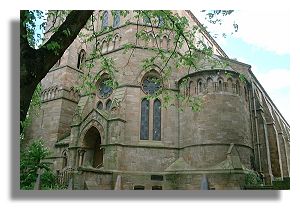
Reprieve for Glasgow West End Church (2002)
It had been widely expected that a landmark church on the corner of Great Western Road and Byres Road in the West End of Glasgow would be converted into 20 luxury flats, removing stained glass windows and interiors in the process. The plans had been denounced as "vandalism" by heritage groups. Earlier this year planning permission for the development of Kelvinside Parish Church, which was built in 1862, was granted by Glasgow City Council. But the building has now been taken over by a new owner who plans to create an arts centre with performance spaces, cafe-bar and possibly even a camera obscura. The stained glass windows would be retained. The venue on a busy corner would be open from 8am through to 2am.
Òran Mór (2012)
Many of the features of the former Kelvinside Parish Church were retained when refurbishment began in 2002 and then opened as the Òran Mór in June 2004. Òran Mór is Gaelic for 'great melody of life' or 'big song' and the building is now a thriving arts & entertainment venue in the heart of Glasgow's West End with a Lounge and Whisky Bar, two Restaurants, Private Dining Room, Live Music venue, Night Club, and a stunning Auditorium with mural ceiling by Alasdair Gray which is the venue for the now nationally recognised ‘A Play, A Pie and A Pint’ lunchtime Theatre.
Ernie Els Wins Open Championship (2002)
After the trials and tribulations of the atrocious weather at Muirfield on Saturday, the sun shone for the final day. South African Ernie Els started on Sunday with a two stroke lead, but despite achieving one under par on the day, he had to face a four-man play-off. It is nerve-wracking enough to march up to the 18th green at the end of 72 holes with the chance of winning the Open. But Els had to do it three times as the play-off after four holes left Els and Frenchman Thomas Levet (who scored 66 on the final day) playing the final hole for a third time in a sudden-death play-off to win the £700,000 first prize - and that claret jug trophy. Tiger Woods recovered from his 81 on Saturday to finish with a 65 on Sunday to show the Muirfield course who was the master. But Colin Montgomerie finished second last, 19 shots behind the winner.
The Big Easy Wins Open Championship Again(2012)
Earlier this year Ernie Els (nicknamed "The Big Easy") failed to qualify for the Masters, the first time since 1993. But at The Open Championship at Royal Lytham & St Annes last weekend, Els finished at 7 under par and was in the club house when Adam Scott, who had been in the lead for much of the tournament, crumbled and bogeyed the last four holes to become second by one shot. Els won the US Open in 1994 and 1997 but was only 9th at this year's US Open last month. As the winner, Ernie Els will take home over $1.4 million (nearly £900,000) out of a total prize money this year of $7,745,085 (£4,958,230). Picture of Ernie Els via Wikimedia.
